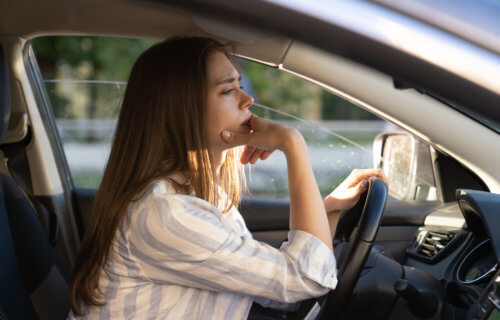BERKELEY, Calif. — Picture this: You’re hopping into your car on a sweltering summer day, ready to crank up the AC and hit the road. But did you know that as you sink into your seat, you might be exposing yourself to a group of chemicals called flame retardants? A new study suggests that these compounds, often added to vehicle interiors to meet safety standards, could be silently seeping into the air you breathe inside your car.
Flame retardants are a bit like the unsung heroes of fire safety. They’re added to all sorts of products, from electronics to furniture, with the intention of slowing down or preventing the spread of flames in the event of a fire. In vehicles, they’re used to comply with the Federal Motor Vehicle Safety Standard (FMVSS) 302, which has been in place since the 1970s. The problem is that many of these chemicals don’t stay put in the materials they’re added to.
You see, a lot of flame retardants are what scientists call “semi-volatile.” This means that they can easily transition from a solid state (like the foam in your car seat) to a gas that ends up in the air. According to this new research, led by scientists at Duke University and the Green Science Policy Institute, the hotter it gets, the more these chemicals are released.
The researchers recruited 101 vehicle owners from across the United States to participate in the study, which is published in Environmental Science & Technology. Each person received a special silicone sampler, which they attached to their car’s rearview mirror for a week. Think of these samplers as chemical sponges – they’re really good at soaking up the compounds floating around in the air. Some participants also collected a small piece of foam from their car seat and sent it to the lab for analysis. All car models in the study were from 2015 or later.
When the scientists analyzed the samplers, they found a wide range of flame retardants, with a class of compounds called organophosphate esters (OPEs) being the most common. One OPE in particular, known as TCIPP, was detected in a staggering 99 percent of the vehicles sampled.
StudyFinds reached out to the Green Science Policy Institute to find out just how concerning this discovery is for drivers. Moreover, is this an issue affecting all major car manufacturers or just the small portion that was tested?
“It’s safe to assume that all makes and models have one or more of these chemicals. We did not test all manufacturers, but we tested a wide variety and every car had flame retardants. Plus, in our conversations with car and foam manufacturers, we have confirmed that flame retardant chemicals are used to meet the NHTSA flammability standard,” co-author Dr. Lydia Jahl, a senior scientist at the Green Science Policy Institute, tells us.
But here’s where things get interesting. The researchers found that the levels of OPEs in the car’s air were significantly higher in the summer compared to the winter. In fact, the average concentration of TCIPP was about four times higher in the summer samples. It’s like these chemicals were having a heat-induced party, releasing more and more of themselves into the air as the temperature climbed.
And remember those foam samples? It turns out that vehicles with TCIPP in their seat foam had much higher levels of the compound in their air – about four times higher in the winter and nine times higher in the summer compared to cars without TCIPP in their foam. This suggests that your car seat could be acting as a reservoir, slowly releasing these chemicals over time.
Dr. Jahl also addressed how concerned motorists should be, particularly those who face longer commutes or who live in warmer climates. The team’s findings are dire.
“Most flame retardants are associated with cancer, brain harms, developmental problems, and reproductive issues. Our study shows that cars are a significant source of our exposure to these chemicals, and those who live in warmer climates, have longer commutes, or who drive as part of their job will have higher exposures. Children are also especially vulnerable as they are still developing and breathe more air pound for pound than adults,” Dr. Jahl explains.
“What makes this especially concerning is that not only are the flame retardants harmful, but the flammability standard that drives their use in cars is outdated and likely ineffective. In other words, there are known health risks for potentially nonexistent fire safety benefits.”

While more research is necessary to fully understand the risks, prior studies have shown that compounds like TCIPP can be inhaled, absorbed through the skin, or even accidentally ingested if they end up in dust that gets on your hands or food. The irony is that while these chemicals are added to vehicles with the intention of improving safety, they may be introducing a different kind of risk.
Now, before you start holding your breath every time you get in your car, it’s important to put this into perspective. We’re exposed to trace amounts of all sorts of chemicals in our daily lives, and our bodies are pretty good at processing them. However, this study does raise some important questions about whether the benefits of adding these compounds to vehicles outweigh the potential risks.
The researchers suggest that one solution could be to reevaluate the flammability standards that are driving the use of flame retardants in vehicles. In recent years, other industries have made changes to reduce the use of these chemicals without compromising fire safety.
“The first thing auto manufacturers should do is encourage NHTSA to update FMVSS 302 to reduce the need for flame retardants. In the meantime, manufacturers should try changing material designs to meet FMVSS 302 without flame retardant chemicals, for example, by using tightly woven textiles that are adhered to the foam,” Dr. Jahl notes.
“Based on work by the Ecology Center in Michigan, we know that some infant car seats (that must meet the same FMVSS 302) can be made without flame retardants – likely by using tightly woven textiles adhered to the foam as mentioned. Manufacturers can also look into design changes to find materials that are inherently more flame retardant, and minimize the use of highly flammable polyurethane foam (which needs flame retardants to meet FMVSS 302)”
As for what drivers and their passengers can do to lower their exposure to the chemicals in their cars, Dr. Jahl says a classic summertime trick really has a host of health benefits: opening car doors to air out the cabin before getting in.
“Yes, opening the doors to let air out for a few minutes before sitting in it should be helpful, as would rolling down the windows for the first few minutes of your drive,” Dr. Jahl tells StudyFinds.
“The only surefire way to drastically reduce exposure would be for flame retardants not to be added in the first place, which will require NHTSA to update its standard. Exterior car covers likely wouldn’t reduce the heat inside a vehicle by too much, so simply opening doors/windows is the best route. As far as we are aware, there aren’t any studies showing whether or not car seat covers help reduce exposure, and some car seat covers could even contain harmful chemicals (like flame retardants or PFAS) themselves.”
Rolling down the windows to let in fresh air while you drive can also help ventilate any built-up chemicals. Additionally, good old-fashioned handwashing is always a smart idea to prevent accidentally ingesting any flame retardant-laden dust.
Consumer Reports created this petition urging the National Highway Traffic Safety Administration to ensure cancer-causing chemicals are kept out of cars.
At the end of the day, this study is a reminder that even seemingly innocuous parts of our everyday environments can have hidden chemical stowaways. As scientists continue to untangle the complex relationship between these compounds and our health, it’s worth taking a moment to appreciate the invisible chemistry at play in our lives – even during something as routine as a summer drive.
StudyFinds Editor-in-Chief Steve Fink contributed to this report.
